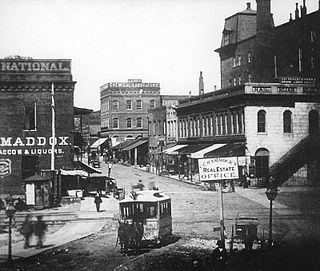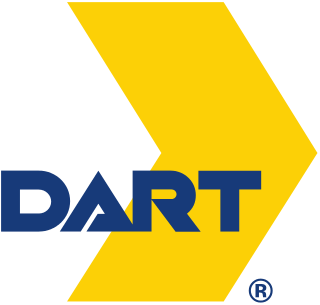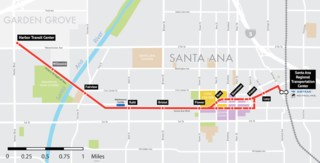
Spokane Transit Authority, more commonly Spokane Transit or STA, is the public transport authority of central Spokane County, Washington, United States, serving Spokane, Washington, and its surrounding urban areas. In 2022, the system had a ridership of 6,995,300, or about 28,900 per weekday as of the first quarter of 2023.

The North–South Rail Link (NSRL) is a proposed rail tunnel, or pair of tunnels, that would connect North Station and South Station in downtown Boston, Massachusetts. The project would build new underground stations near the existing stations, connect them with about 1.5 miles (2.4 km) of tunnels, and add other tunnels to link up with existing surface tracks.

The San Diego Trolley is a light rail system operating in the metropolitan area of San Diego. It is known colloquially as "The Trolley". The Trolley's operator, San Diego Trolley, Inc. (SDTI), is a subsidiary of the San Diego Metropolitan Transit System (MTS). The Trolley began service on July 26, 1981, making it the oldest of the second-generation light rail systems in the United States. The Trolley system serves 62 stations, comprises 65 miles (105 km) of route, three primary lines that operate daily, and one heritage line that operates on a circuit of downtown on select days. In 2022, the Trolley had the fifth highest ridership of light rail systems in the United States, with 34,053,400 annual rides, or about 109,500 per weekday as of the first quarter of 2023.
The Urban Ring was a proposed project of the Massachusetts Bay Transportation Authority and the Massachusetts Department of Transportation, to develop new public transportation routes that would provide improved circumferential connections among many existing transit lines that project radially from downtown Boston. The Urban Ring Corridor is located roughly one to two miles from downtown Boston, passing through the Massachusetts cities of Boston, Chelsea, Everett, Medford, Somerville, Cambridge, and Brookline. The project was expected to convert 41,500 car trips to transit trips daily.

The MAX Green Line is a light rail service in Portland, Oregon, United States, operated by TriMet as part of the MAX Light Rail system. It is 15 miles (24.1 km) long and serves 30 stations from the PSU South stations to Clackamas Town Center Transit Center; it connects Portland State University (PSU), Portland City Center, Northeast Portland, Southeast Portland, and Clackamas. The Green Line is the only service that shares parts of its route with the four other MAX services, sharing the Portland Transit Mall with the Orange and Yellow lines and the Banfield segment of the Eastside MAX with the Blue and Red lines. Southbound from Gateway/Northeast 99th Avenue Transit Center, it operates the Interstate 205 (I-205) segment through to Clackamas Town Center. Service runs for approximately 211⁄2 hours daily with a headway of 15 minutes during most of the day. It is the third-busiest line in the system, carrying an average of 19,160 riders per day on weekdays in September 2019.

The Red Line is a proposed east–west transit line for Baltimore, Maryland. The project was granted federal approval to enter the preliminary engineering phase and the Maryland Transit Administration had spent roughly $300 million in planning, design and land acquisition, until Maryland Governor Larry Hogan declared on June 25, 2015 that he would not provide state funds for the project, instead shifting $736 million of state funding to roads in suburban areas. The Red Line had been projected to cost roughly $1.6 billion, $900 million of which would have been guaranteed federal funding.
The Chicago Central Area Transit Plan, generally referred to as the Chicago Central Area Transit Project (CCATP) in the 1970s, was an extensive study of the rapid transit system in downtown Chicago; the study had begun in 1965.
The Bottineau LRT is a proposed light rail line extension in the Minneapolis – Saint Paul Metro area, projected to run northwest from Target Field station in downtown Minneapolis along County Road 81 to Brooklyn Park.

Streetcars originally operated in Atlanta downtown and into the surrounding areas from 1871 until the final line's closure in 1949.

DART Light Rail is the light rail system serving the metropolitan area of Dallas, Texas and is owned and operated by Dallas Area Rapid Transit (DART). The DART Light Rail system opened June 14, 1996 and serves 65 stations and four lines, covering 93 miles (149.7 km): the Red Line, the Blue Line, the Green Line, and the Orange Line.

The Silver Line is a 2.7-mile (4.3 km) heritage streetcar line operated by the San Diego Trolley, an operating division of the San Diego Metropolitan Transit System. It currently operates the "downtown loop"; a circle of tracks around Downtown San Diego, and is operated using renovated historic vehicles. The line is one of four lines in the Trolley system; the others include the Blue, Orange, and Green lines.

Metro is a transit network in Minnesota serving the cities of Minneapolis and Saint Paul. It also provides service to some suburban areas. As of 2022 the system consists of two light rail lines and five bus rapid transit (BRT) lines all of which are operated by the local public transit company: Metro Transit. The five lines connect Downtown Minneapolis and St Paul with the Bloomington, Minneapolis-St Paul International Airport, Roseville, Richfield, Burnsville and Brooklyn Center.
Streetcars were the primary mode of public transport in Tacoma, Washington, United States from the late 1800s until their discontinuance in 1938. Operated together with a network of interurbans, streetcars provided transport within Tacoma and throughout the Puget Sound region. Buses replaced the last streetcars in 1938. Streetcar-type transportation returned to Tacoma in 2003 with the opening of the Tacoma Link, a 1.6-mile (2.6 km) light rail line in Downtown Tacoma. There are proposals both to expand this system and to construct a new heritage streetcar system.

The O-Train is a light metro transit system in Ottawa, Ontario, Canada, operated by OC Transpo. The O-Train system has two lines, the electrically-operated Confederation Line and the diesel-operated Trillium Line. Since May 2020, Stage 2 construction has temporarily shut down Line 2, with replacement bus service being offered at all stations. When Line 2 reopens in late 2023, it will extend southward to Limebank station and incorporate five newly constructed stations, as well as an additional line linking Line 2 to Ottawa International Airport which will replace the current bus service from route 97. By 2026, expansions along Line 1 and the construction of Line 3 stations in the west end are expected to be complete, bringing the system's length to 64.5 km (40.1 mi), four lines and 41 stations. The O-Train network is fully grade separated and does not have any level crossings with roads.

The OC Streetcar is a modern streetcar (LRT) line currently under construction in Orange County, California, running through the cities of Santa Ana and Garden Grove. The electric-powered streetcar will be operated by the Orange County Transportation Authority (OCTA), and will serve ten stops in each direction along its 4.15-mile (6.68 km) route. With the exception of a short loop in downtown Santa Ana, the line will be double-tracked for its entire length. Most of the route follows the original path of the Pacific Electric Railway "Red Cars" that served Santa Ana in the early 20th century, before being abandoned in 1950. Construction on the streetcar broke ground on November 30, 2018, and the line expected to open to the public in 2024.

The City Line is a bus rapid transit (BRT) line in Spokane, Washington, United States, that opened on July 15, 2023. The 6-mile-long (9.7 km) route, which is operated by the Spokane Transit Authority, runs from Spokane's Browne's Addition neighborhood, through Downtown Spokane and the University District, including the WSU Health Sciences campus and Gonzaga University, before ending at the Spokane Community College campus in the Chief Garry Park neighborhood. The project budget as of 2023 was $92.2 million.
Pence-Cole Valley Transit Center is a transit center and former proposed site of a light rail station in the Spokane Transit Authority route system. It is one of Spokane Transit's three primary transit centers, along with the Spokane Community College and STA Plaza, and is the main transit hub for Spokane Valley.
The West Santa Ana Branch Transit Corridor is a planned light rail line, mostly following the Pacific Electric's historic West Santa Ana Branch, connecting Downtown Los Angeles to the city of Artesia, along with other cities in southeastern Los Angeles County.
The history of the Los Angeles Metro Rail and Busway system begins in the early 1970s, when the traffic-choked region began planning a rapid transit system. The first dedicated busway opened along I-10 in 1973, and the region's first light rail line, the Blue Line opened in 1990. Today the system includes over 160 miles (260 km) of heavy rail, light rail, and bus rapid transit lines, with multiple new lines under construction as of 2019.

Division Bus Rapid Transit, also known as Division BRT, is the working name for a planned bus rapid transit line in Spokane, Washington that will extend 9 miles from Downtown Spokane to the Mead, Washington area, north of Spokane. The line will be operated by Spokane Transit Authority, with a planned launch in 2027, and will be the region's second bus rapid transit line, after the City Line.













